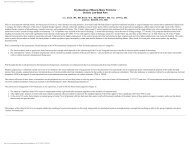A Proposed Clinical Reasoning Model For Western Acupuncture
A Proposed Clinical Reasoning Model For Western Acupuncture
A Proposed Clinical Reasoning Model For Western Acupuncture
Create successful ePaper yourself
Turn your PDF publications into a flip-book with our unique Google optimized e-Paper software.
Key Messages:<br />
• The western approach to acupuncture as<br />
practised by many physiotherapists has been<br />
criticised because of the lack of clinical reasoning<br />
underpinning treatment choices. In accordance<br />
with recent advances in the understanding<br />
neurophysiology and pain mechanisms western<br />
acupuncture can now be implemented with<br />
more reference to the basic sciences.<br />
• A clinical reasoning model-the ‘layering<br />
process’, based on physiological mechanisms,<br />
is proposed to assist acupuncturists in making<br />
treatment choices. The recommended<br />
progressions use different mechanisms in the<br />
central nervous system.<br />
• The model relies on orthodox physiotherapy<br />
diagnosis and prior knowledge of anatomy,<br />
physiology, pathology and acupuncture point<br />
locations. Detailed knowledge of somatic and<br />
sympathetic neuroanatomy along with<br />
physiological mechanisms is also required to<br />
implement the model.<br />
• While the model has not been validated by<br />
scientific investigation, physiotherapists<br />
practicing western acupuncture are<br />
encouraged to consider the layering process<br />
and its possible contribution to the practice of<br />
western acupuncture.<br />
ACKNOWLEDGEMENTS<br />
This clinical commentary is based on a paper presented<br />
at the AACP/IAAPT <strong>Acupuncture</strong> Conference, 2001, Latimer<br />
Conference Center, London. An earlier version was published<br />
in the <strong>Acupuncture</strong> Association of Chartered Physiotherapists<br />
(AACP) Journal (March 2002) and the International<br />
<strong>Acupuncture</strong> Association of Physiotherapists (IAAPT) newsletter<br />
(November 2001). The author would like to acknowledge<br />
Louise Johnson for valuable input into the development of the<br />
model.<br />
References<br />
Bekkering R, van Bussel R (1998). Segmental <strong>Acupuncture</strong>. In<br />
J. Filshie & A. White (Eds.): Medical <strong>Acupuncture</strong>: A <strong>Western</strong><br />
Scientific Approach, Churchill Livingstone.<br />
Bradnam L (2001). <strong>Western</strong> <strong>Acupuncture</strong> Point Selection: A<br />
Scientific <strong>Clinical</strong> <strong>Reasoning</strong> <strong>Model</strong>. Meridian Worldwide –<br />
Newsletter of the International <strong>Acupuncture</strong> Association of<br />
Physical Therapists 10(2), October, 9-18.<br />
Carlsson C (2002). <strong>Acupuncture</strong> Mechanisms for <strong>Clinical</strong>ly<br />
Relevant Long-term Effects - reconsideration and a<br />
hypothesis. <strong>Acupuncture</strong> in Medicine 20(2-3) 82-99.<br />
Coderre T, Arroyo J, Champion G (1993). Contribution of Central<br />
Neuroplasticity to Pathological Pain. A Review of clinical and<br />
experimental research. Pain, 52, 259-285.<br />
Filshie J, Cummings M (1999). <strong>Western</strong> Medical <strong>Acupuncture</strong>.<br />
In E. Ernst & A. White (Eds.), <strong>Acupuncture</strong>. A Scientific<br />
Appraisal (pp. 31-59). Oxford: Butterworth-Heinemann.<br />
Gifford LS, Butler DS (1997). The Integration of Pain Sciences into<br />
<strong>Clinical</strong> Practice. Journal of Hand Therapy, April-June, 87-95.<br />
Jones M (1995). <strong>Clinical</strong> <strong>Reasoning</strong> and Pain. Manual Therapy,<br />
1, 17-24.<br />
Kandell E, Schwartz J, Jessell T (Eds) (2000). Principles of Neural<br />
Science. 4 th Edition. McGraw-Hill Health Professions<br />
Division, USA.<br />
Liao T-J, Urata S, Nishikawa H (1998). Transient Decrease in<br />
Skin Resistance Response and Level at the Deh-Chi stage<br />
caused by Manual <strong>Acupuncture</strong>. Tohoku Journal of<br />
Experimental Medicine, 186, 19-25.<br />
Lundeberg T (1998). The Physiological Basis of <strong>Acupuncture</strong>.<br />
Paper presented at the MANZ/PAANZ Annual Conference,<br />
Christchurch, New Zealand.<br />
Lundeberg T (1996). Electrical Stimulation Techniques<br />
[comments]. Lancet, 348, 1672-1673.<br />
Lundeberg T (1999). Effects of Sensory Stimulation<br />
(<strong>Acupuncture</strong>) on Circulatory and Immune Systems. In E.<br />
Ernst & A. White (Eds.), <strong>Acupuncture</strong>: A Scientific Appraisal<br />
(pp. 93-106): Butterworth Heinemann.<br />
Lundeberg T, Ekholm J (2001). Pain - From Periphery to Brain.<br />
Journal of the <strong>Acupuncture</strong> Association of Chartered<br />
Physiotherapists, February 2001, 13-19.<br />
Lundeberg T, Hurtig T, Lundeburg S, Thomas M (1988a). Long<br />
Term Results of <strong>Acupuncture</strong> in Chronic Head and Neck<br />
Pain. Pain Clinic, 2, 15-31.<br />
Lundeberg T, Kjartansson J, Samuelsson U (1988b). Effect of<br />
electrical Nerve Stimulation on Healing of Ischaemic Skin<br />
Flaps. Lancet, ii, 712-714.<br />
Melzack R, Stillwell D, Fox E (1977). Trigger Points and <strong>Acupuncture</strong><br />
Points for Pain, Correlations and Implications. Pain, 3, 3-23.<br />
Myers RR (1995). The Pathogenesis of Neuropathic Pain. Regional<br />
Anesthesia, 20(3), 173-184.<br />
Sjolund B, Terenius L, Eriksson M (1977). Increased cerebrospinal<br />
Fluid Levels of Endorphins after Electroacupuncture. Acta<br />
Pysiological Scandinavia, 100(3) 382-384.<br />
Sato A, Sato Y, Schmidt R (1997). The Impact of Somatosensory<br />
Input on Autonomic Functions. Heidleberg: Springer-Verlag.<br />
Stener-Victorin E (2000). <strong>Acupuncture</strong> in Reproductive Medicine,<br />
Goteborg University Sweden, Goteborg.<br />
White A. (1999). Neurophysiology of <strong>Acupuncture</strong> Analgesia. In<br />
E. Ernst & A. White (Eds.), <strong>Acupuncture</strong>: A Scientific Appraisal<br />
(pp. 60-92): Butterworth-Heinemann.<br />
Wiesenfeld-Hallin Z, Zu X (1996). Plasticity of Messenger<br />
Function in Primary Afferents following Nerve Injury -<br />
implications for Neuropathic pain. In G Carli &<br />
M Zimmerman (Eds.), Progress in Brain Research (Vol. 110):<br />
Elsevier Science.<br />
Woolf C, Costigan M (1999). Transcriptional and<br />
Posttranscriptional Plasticity and the Generation of<br />
Inflammatory Pain. Proceedings of the National Academy of<br />
Science, 96 July, 7723-7730.<br />
Yu Y-H, Wang H-C, Wang Z-J (1995). The Effect of <strong>Acupuncture</strong><br />
on Spinal Motor Neuron Excitability in Stroke Patients.<br />
Chinese Medical Journal, 56, 258-63.<br />
1st Choice AD<br />
NZ Journal of Physiotherapy – March 2003. Vol. 31,1 45






